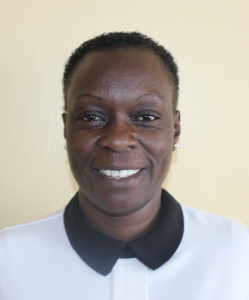Mwichina Primary School was established in 1978 on a 1.5-acre parcel of land full of rocks. It is sponsored by the Anglican Church of Kenya. The classes began under a tree, and Head Teacher Mr. Silas Ominde told us the school has not changed much since then as it still has the same water problems it did when it opened.
The school primarily depends on a protected spring off-campus that is shared with community members, and a small 5,000-liter rain tank on school grounds. The current rain tank is tiny compared to the 446 students and staff who depend on it, and it never meets their needs. The spring is quite far from school, which means pupils waste a lot of time when they go to fetch water from it. As the students compete with community members for water, it reaches a time when school children are requested to wait or chased away until all community members fetch water before they do.
Pupils come back so tired from the spring and cannot study well when exhausted. This, in the end, affects their academic performance. Because it is the pupils who fetch water for school use, they are also the ones who pay the price when water is not readily available for drinking, cooking, or cleaning.
"This school has not found any donor or partner to [help us] access clean and safe water. The pupils have to draw water from the protected spring thus affecting their study time which in turn affects their academic performance. I am very happy that God has led you to come to our school and rescue the situation," said Mr. Livingstone Obutiti, the Deputy Head Teacher at the school.
We first learned about Mwichina Primary School's situation through a connection from the Head Teacher of Shibinga Primary School, who encouraged Mr. Ominde to contact our team of field officers to initiate a visit. We have been working with Mwichina Primary ever since. The school population now stands at 425 students with 18 teachers and 3 staff.
Mwichina is a rural area with hilly and rocky terrain. Neighbors of the school grow mainly maize for subsistence and sugarcane as a cash crop. Illiteracy and poverty continue to pose challenges to community members here and often stagnate development in the area. Most of the buildings here are semi-permanent, with iron sheet roofs and mud walls.
The school has 16 permanent classrooms, a small kitchen, and a dirt playing field. They do not have handwashing facilities or any container with water close to their few latrines. The latrines are very dirty which means they are not cleaned frequently because there is not enough water to spare to do so.
"Poor hygiene can cause diseases that could even lead to death," said Mr. Silas Ominde, the Head Teacher at the school.
"Pupils do not understand the importance of practicing good sanitation and hygiene and when we tell them, they still do nothing. There is [a] need to take matters concerning hygiene and sanitation seriously among the pupils."
Pupils report to school by 7:00 am. Upon arrival, they either head to the spring for water or carry out the cleaning of the compound, then start normal lessons at 8:00 am which go to 9:30 am when they go to break for 15 minutes. They get back to class at 9:45 am until 12:45 pm, when they are released for lunch. After lunch, the pupils return at 2:00 pm to attend afternoon lessons which end at 4:00 pm until the following day. Fetching water from the spring occurs throughout the day, as water is needed and as it runs out, interrupting valuable class and study time.
What we can do:
Rain Tank
A 50,000-liter rain tank will help alleviate the water crisis at this school. The school will help collect the needed construction materials such as sand, bricks, rocks, and water for mixing cement. We will complement their materials by providing an expert team of artisans, tools, hardware, and the guttering system. Once finished, this tank will begin catching rainfall that will be used by the school’s students and staff for drinking, handwashing, cooking, cleaning, and much more.
We and the school strongly believe that all of these components will work together to improve standards at this school, which will help lead to better student academic performance and will help to unlock the potential for these students to live better, healthier lives.
Handwashing Stations
There is currently nowhere for students to wash their hands after using the latrines or before eating lunch, let alone the water to do so.
The student health club will oversee the 2 new handwashing stations we will provide, and make sure they are kept clean and in working condition. The club leaders will fill the handwashing stations with water daily and make sure they are always supplied with a cleaning agent such as soap or ash.
VIP Latrines
2 triple-door latrine blocks will be constructed with local materials that the school will help gather. 3 doors will serve the girls while the other 3 will serve the boys. All of these new latrines will have cement floors that are designed to be easy to use and to clean. And with a rain tank right on school property, there should be enough water to keep them clean.
Training
We will hold a 1-day intensive training on improved hygiene, health, and sanitation habits at this school. Our team of facilitators will use a variety of methods to train students and staff on a wide range of topics, including participatory hygiene and sanitation transformation (PHAST) and asset-based community development (ABCD). We will initiate a child-to-child (CTC) student health club, which will prepare students to lead other pupils into healthy habits at school and at home. We will also lead lectures, group discussions, and provide illustrative handouts to teach health topics and ways to promote good hygiene practices within the school including handwashing and water treatment. We will then conduct a series of follow-up trainings before transitioning to our regularly scheduled support visits throughout the year.

 Rainwater Catchment
Rainwater Catchment
 Rehabilitation Project
Rehabilitation Project


































